Tuccamirgan’s Pipe Rediscovered in HCHS Archives
(Written by David Harding and first published in Hunterdon Historical Record, Summer 2017.)
In the mid-1700s, the chief of a local Native American village, Tuccamirgan, presented his friend and neighbor, John Philip Case, with a pipe to symbolize their decades’ long friendship. The pipe remained in the Case family for a number of years, getting handed down from generation to generation until it was given to the Hunterdon County Historical Society in 1925.
Ninety-two years later, that pipe was giving Patricia Millen a massive headache.
Millen had been hearing about the pipe periodically since first taking the job of executive director of HCHS two years ago. On this fateful January day, talk of the pipe seemed to be on the lips of quite a few people as she fielded phone calls and an inquiry from a researcher about it. No particular reason, sometimes coincidence works that way.
“I had handled the box when I was first hired, but set it aside because I wanted someone else to look at the spear points,” she said. Millen rushed to the box, opened it, and unrolled a crumpled old newspaper. “I put my hands on it and said ‘Oh my God, this has to be the pipe bowl.”
But there was one problem: The pipe had been missing for more than 15 years. It’s the rarest of occurrences for an organization with a massive collection of books, papers, artifacts, photographs and files – but it happened.
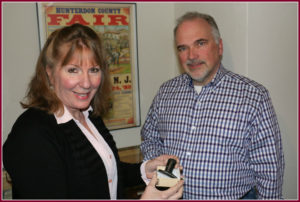
“I had such a headache when I went home that day because I couldn’t stop thinking about it,” Millen said. “I was getting obsessed about it.”
The next day, Millen channeled her inner-Sherlock Holmes. A key clue was uncovered by librarian Pam Robinson when she discovered a vertical file with a letter and two newspaper articles from the 1920s about the pipe. The letter mentioned the pipe was actually a pipe bowl without a stem. Millen figured she had touched every box in the Hiram Deats collection multiple times, except for one box she had found in an upstairs cupboard labeled “Fish Spears Found in Salem County.”
“I had handled the box when I was first hired, but set it aside because I wanted someone else to look at the spear points,” she said. Millen rushed to the box, opened it, and unrolled a crumpled old newspaper. “I put my hands on it and said ‘Oh my God, this has to be the pipe bowl.”
A Most Unusual Piece
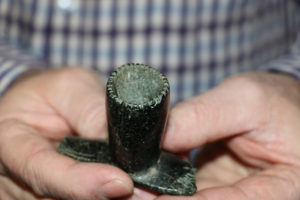
The Tuccamirgan pipe is a particular form now known as a “Monitor” or platform pipe, named by Native American researcher George A. West described the pipe’s shape reminded him of the Civil War ironclad. The base of the pipe bowl is three inches long and the bowl itself is three inches high, and is made from soapstone or, more formally, steatite. These types of pipes are generally believed to date from the Middle Woodland period, roughly A.D 410-1180.
“This means that the pipe would have been quite old by the time Tuccamirgan acquired it,” said Dr. Richard Veit, who teaches anthropology and is chair of the History and Anthropology Department at Monmouth University.
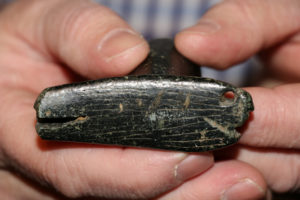
The pipe’s base bears a startling resemblance to a fish, but Dr. Veit thinks this might be accidental. “I believe the two holes were drilled through it, perhaps to suspend feathers. One broke the pipe – the mouth, and the other looks like an eye. The notches around the bowl are also unusual.”
Dr. Veit said all this raises a number of interesting questions: Was it made more than a thousand years ago and then found and used in the historic period? Did people at different times try to improve the pipe by cutting the notches around the bowl and drill the two holes through the far end? Was the pipe handed down for centuries among Native Americans before Chief Tuccamirgan presented it to Case?
His Blue Brother
Johan Philip Kaes (later Anglicized to Kase and then Case) emigrated from German Palatinate and arrived in the Flemington area around 1730. He purchased 374 acres from the sons of William Penn, settling along the Walnut Brook on what is now the Hunterdon Land Trust’s Case-Dvoor Farmstead.
Local tradition holds that Case erected a log cabin somewhere between the present bank barn and the brook with the help of the Delaware Indians. Historian Elias Vosseller wrote in 1891: “A strong friendship sprang up between Mr. Case and (Chief Tuccamirgan). The Chief called him his blue brother, the significance of which is not clear. They smoked the pipe of peace together and the bowl of that pipe, which the chief gave to Mr. Case, is now in the possession of John B. Case of Flemington, his great-grandson.”
Before dying around 1750, Tuccamirgan asked to be buried in the Case family cemetery on Bonnell Street. Supposedly, he said they had all lived together in peace and he wished to be buried together in peace. The Chief’s grave was dug very deep, and he was buried in a sitting position with his war and hunting implements, Vosseller wrote.
Tuccamirgan and his wife might also deserve credit for running the Flemington area’s first baby-sitting service: According to Vosseller, the chief and his wife had no children but would frequently visit the Cases to borrow some of their kids and “take them to her wigwam and keep them all day.”
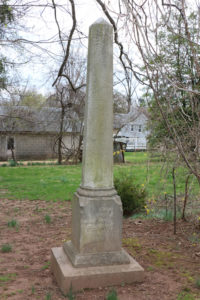
Before dying around 1750, Tuccamirgan asked to be buried in the Case family cemetery on Bonnell Street. Supposedly, he said they had all lived together in peace and he wished to be buried together in peace. The Chief’s grave was dug very deep, and he was buried in a sitting position with his war and hunting implements, Vosseller wrote.
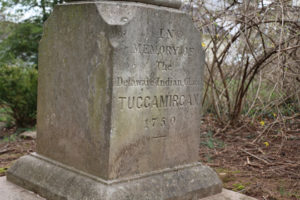
On Oct. 19, 1925, locals gathered in the Case family cemetery to dedicate the marble shaft created to honor Chief Tuccamirgan. According to the Hunterdon Republican account, “At 3 o’clock the Flemington Concert Band, escorting Wickcheoche Tribe and Wickcheoche Council, Daughters of Pocahontas, both organizations in Indian regalia, marched to the ground where a large number of people had gathered.” The Case family gave HCHS the pipe around the time of the monument’s dedication.
More than 90 years later, the pipe bowl was reunited with a Johan Philip Case descendant when William Van Natta visited the Hiram E. Deats Memorial Library. Van Natta’s face beamed as he held the pipe that once belonged to his great-great-great-great-great grandfather.
“This is so cool — I’m just beside myself,” Van Natta said as he gently turned the pipe bowl over in his hands, marveling at this historic treasure.
HCHS plans to display the pipe in the future.
Support for this program is provided in part by a grant from the Astle-Alpaugh Family Foundation. A special thanks to Mr. Bob Sands, Project Manager and consultants Dr. Richard Veit and Dr. Gregory Herman.
